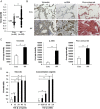Autoimmunity to Vimentin Is Associated with Outcomes of Patients with Idiopathic Pulmonary Fibrosis
- PMID: 28754682
- PMCID: PMC5563167
- DOI: 10.4049/jimmunol.1700473
Autoimmunity to Vimentin Is Associated with Outcomes of Patients with Idiopathic Pulmonary Fibrosis
Abstract
Autoimmunity has been implicated in the pathogenesis of idiopathic pulmonary fibrosis (IPF); however, the repertoire of autoantigens involved in this disease and the clinical relevance of these autoimmune responses are still being explored. Our initial discovery assays demonstrated that circulating and intrapulmonary vimentin levels are increased in IPF patients. Subsequent studies showed native vimentin induced HLA-DR-dependent in vitro proliferation of CD4 T cells from IPF patients and enhanced the production of IL-4, IL-17, and TGF-β1 by these lymphocytes in contrast to normal control specimens. Vimentin supplementation of IPF PBMC cultures also resulted in HLA-DR-dependent production of IgG with anti-vimentin specificities. Circulating anti-vimentin IgG autoantibody levels were much greater in IPF subjects from the University of Alabama at Birmingham (n = 102) and the University of Pittsburgh (U. Pitt., n = 70) than in normal controls. Anti-vimentin autoantibody levels in IPF patients were HLA biased and inversely correlated with physiological measurements of lung function (i.e., forced expiratory volumes and diffusing capacities). Despite considerable intergroup differences in transplant-free survival between these two independent IPF cohorts, serious adverse outcomes were most frequent among the patients within each population that had the highest anti-vimentin autoantibody levels (University of Alabama at Birmingham: hazard ratio 2.5, 95% confidence interval 1.2-5.3, p = 0.012; University of Pittsburgh: hazard ratio 2.7, 95% confidence interval 1.3-5.5, p = 0.006). These data show that anti-vimentin autoreactivity is prevalent in IPF patients and is strongly associated with disease manifestations. These findings have implications with regard to the pathogenesis of this enigmatic disease and raise the possibility that therapies specifically directed at these autoimmune processes could have therapeutic efficacy.
Copyright © 2017 by The American Association of Immunologists, Inc.
Figures






Similar articles
-
Cellular and humoral autoreactivity in idiopathic pulmonary fibrosis.J Immunol. 2007 Aug 15;179(4):2592-9. doi: 10.4049/jimmunol.179.4.2592. J Immunol. 2007. PMID: 17675522 Clinical Trial.
-
The HLA class II Allele DRB1*1501 is over-represented in patients with idiopathic pulmonary fibrosis.PLoS One. 2011 Feb 23;6(2):e14715. doi: 10.1371/journal.pone.0014715. PLoS One. 2011. PMID: 21373184 Free PMC article.
-
Patients with idiopathic pulmonary fibrosis with antibodies to heat shock protein 70 have poor prognoses.Am J Respir Crit Care Med. 2013 Apr 1;187(7):768-75. doi: 10.1164/rccm.201203-0506OC. Am J Respir Crit Care Med. 2013. PMID: 23262513 Free PMC article.
-
Semaphorin 7a+ regulatory T cells are associated with progressive idiopathic pulmonary fibrosis and are implicated in transforming growth factor-β1-induced pulmonary fibrosis.Am J Respir Crit Care Med. 2013 Jan 15;187(2):180-8. doi: 10.1164/rccm.201206-1109OC. Epub 2012 Dec 6. Am J Respir Crit Care Med. 2013. PMID: 23220917 Free PMC article.
-
Angiotensin-TGF-beta 1 crosstalk in human idiopathic pulmonary fibrosis: autocrine mechanisms in myofibroblasts and macrophages.Curr Pharm Des. 2007;13(12):1247-56. doi: 10.2174/138161207780618885. Curr Pharm Des. 2007. PMID: 17504233 Review.
Cited by
-
Systemic sclerosis biomarkers detection in the secretome of TGFβ1-activated primary human lung fibroblasts.J Proteomics. 2021 Jun 30;242:104243. doi: 10.1016/j.jprot.2021.104243. Epub 2021 Apr 27. J Proteomics. 2021. PMID: 33930553 Free PMC article.
-
A repertoire of 124 potential autoantigens for autoimmune kidney diseases identified by dermatan sulfate affinity enrichment of kidney tissue proteins.PLoS One. 2019 Jun 25;14(6):e0219018. doi: 10.1371/journal.pone.0219018. eCollection 2019. PLoS One. 2019. PMID: 31237920 Free PMC article.
-
Anti-vimentin antibodies: a unique antibody class associated with therapy-resistant lupus nephritis.Lupus. 2020 May;29(6):569-577. doi: 10.1177/0961203320913606. Epub 2020 Mar 26. Lupus. 2020. PMID: 32216516 Free PMC article.
-
Recombinant Human Vimentin Binds to P-Selectin and Blocks Neutrophil Capture and Rolling on Platelets and Endothelium.J Immunol. 2018 Mar 1;200(5):1718-1726. doi: 10.4049/jimmunol.1700784. Epub 2018 Jan 15. J Immunol. 2018. PMID: 29335256 Free PMC article.
-
Machine learning-based integration identifies plasma cells-related gene signature ST6GAL1 in idiopathic pulmonary fibrosis.BMC Pulm Med. 2025 Jul 2;25(1):295. doi: 10.1186/s12890-025-03696-9. BMC Pulm Med. 2025. PMID: 40604645 Free PMC article.
References
-
- Raghu G., Collard H. R., Egan J. J., Martinez F. J., Behr J., Brown K. K., Colby T. V., Cordier J. F., Flaherty K. R., Lasky J. A., et al. ATS/ERS/JRS/ALAT Committee on Idiopathic Pulmonary Fibrosis 2011. An official ATS/ERS/JRS/ALAT statement: idiopathic pulmonary fibrosis: evidence-based guidelines for diagnosis and management. Am. J. Respir. Crit. Care Med. 183: 788–824. - PMC - PubMed
-
- Ogushi F., Tani K., Endo T., Tada H., Kawano T., Asano T., Huang L., Ohmoto Y., Muraguchi M., Moriguchi H., Sone S. 2001. Autoantibodies to IL-1 alpha in sera from rapidly progressive idiopathic pulmonary fibrosis. J. Med. Invest. 48: 181–189. - PubMed
-
- Feghali-Bostwick C. A., Tsai C. G., Valentine V. G., Kantrow S., Stoner M. W., Pilewski J. M., Gadgil A., George M. P., Gibson K. F., Choi A. M., et al. 2007. Cellular and humoral autoreactivity in idiopathic pulmonary fibrosis. J. Immunol. 179: 2592–2599. - PubMed
-
- Taillé C., Grootenboer-Mignot S., Boursier C., Michel L., Debray M. P., Fagart J., Barrientos L., Mailleux A., Cigna N., Tubach F., et al. 2011. Identification of periplakin as a new target for autoreactivity in idiopathic pulmonary fibrosis. Am. J. Respir. Crit. Care Med. 183: 759–766. - PubMed
-
- Magro C. M., Waldman W. J., Knight D. A., Allen J. N., Nadasdy T., Frambach G. E., Ross P., Marsh C. B. 2006. Idiopathic pulmonary fibrosis related to endothelial injury and antiendothelial cell antibodies. Hum. Immunol. 67: 284–297. - PubMed
Publication types
MeSH terms
Substances
Grants and funding
LinkOut - more resources
Full Text Sources
Other Literature Sources
Medical
Research Materials

